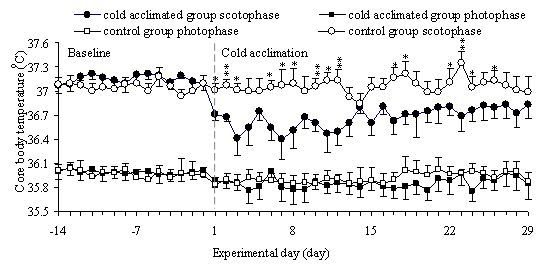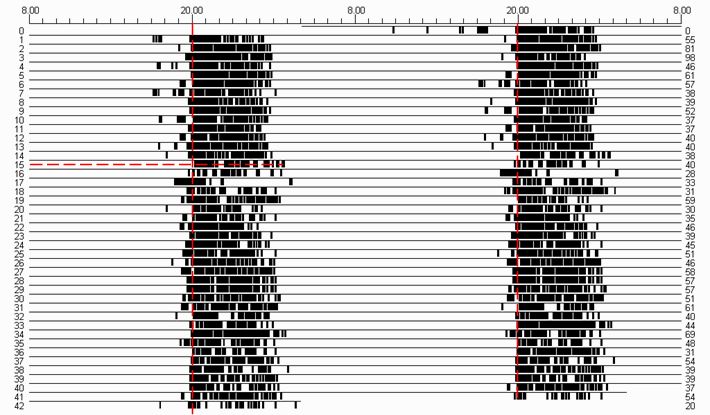Desert hamsters (Phodopus roborovskii) are one of the 3 species in genus Phodopus with a body mass of only around 20g. Compared with the plentiful knowledge about Siberian hamsters (Phodopus sungrus), which also belong to the same genus and are very famous as a model in seasonal adaptation research, there is only limited information about the energetics and thermal physiology in desert hamsters. To examine the potential effects of cold temperature on thermal physiology and energetics in male desert hamsters, animals were exposed to 5oC for 4 weeks under 16L:8D (light-dark) circles. Core body temperature and gross activity were telemetrically monitored. Thermogenic capacity measured as oxygen consumption was determined with an open-flow respirometer. Wheel running activity was also recorded to reflect animals’ activity level or foraging efforts.
During the entire experiment, all desert hamsters maintained a high core body temperature almost always above 34oC. No signs of torpor were detected in any of the hamsters. This suggests that desert hamsters may defend a relative high body temperature during cold exposure in the wild at least when without food shortage. However, it should be acknowledged that in Siberian hamsters the key factor that triggers torpor expression is reduced photoperiod, rather than reduced temperature alone. We cannot therefore completely rule out the possibility that desert hamsters may also show torpor if both temperature and photoperiod are simultaneously manipulated. Actually, we had found in another experiment that desert hamsters reared at 23oC could show reduced core body temperature below 30oC when food was deprived.
Desert hamsters are typical nocturnal mammals and showed robust dominating circadian rhythms in core body temperature, gross activity and wheel running behavior in all animals before and after cold acclimation. Mean core body temperature in cold acclimated desert hamsters decreased by 0.21oC compared with controls. Further analysis revealed that the decrease mainly occurred in the scotophase, while in the photophase core body temperature remained constant during the whole cold acclimation. This suggests the hamsters may have down regulated the photophase core body temperature to a suitable low values which may be adapted to maximize energy saving while ensuring normal activity levels possible (Fig. 1).
As often seen in other small mammals, thermogenic capacity, represented by resting metabolic rate and nonshivering thermogenesis increased in cold acclimated hamsters significantly. Food intake, apparent digestibility and digestible energy in cold acclimated hamsters were also significantly elevated accompanied by adaptive changes in morphology of digestive tracts. The wheel running turns and the onset of wheel running remained unchanged (Fig. 2). This study indicated that desert hamsters remained very active during cold acclimation and displayed adaptive changes in thermal physiology and energy metabolism, such as enhanced thermogenic and energy processing capacities.
This study was financially supported by grants from the National Natural Science Foundation of China (30625009), Chinese Academy of Sciences (KSCX2-YW-Z-1021) and the National Science and Technology Ministry Project (2007BC109103) and to Dehua Wang (Chi Qing-Sheng and Wang De-Hua. 2010. Thermal physiology and energetics in male desert hamsters (Phodopus roborovskii) during cold acclimation. J Comp Physiol B. DOI 10.1007/s00360-010-0506-6).

Fig. 1 Effects of cold acclimation on photophase and scotophase core body temperature in male desert hamsters. One or two asterisks indicate significant or very significant difference between the two groups respectively. The vertical grey dashed line indicates the day when cold acclimation began.

Fig. 2 Double-plot actogram of wheel running turns in a representative cold acclimated male desert hamster. On top is the clock hour. On the left and right are the experimental day and the mean wheel running turns over the day, respectively. The black section in each line represents values above the mean of the day, while the white sections represent the values below the mean. Vertical dashed lines indicate the time when scotophase started. Horizontal dashed lines indicate the day when cold acclimation began.


